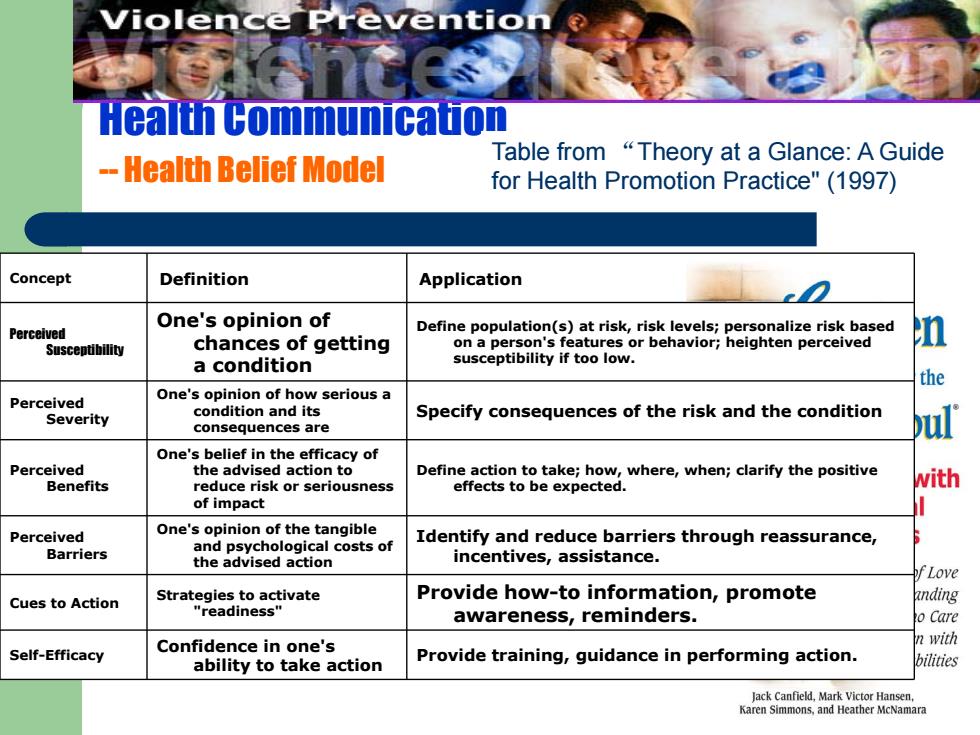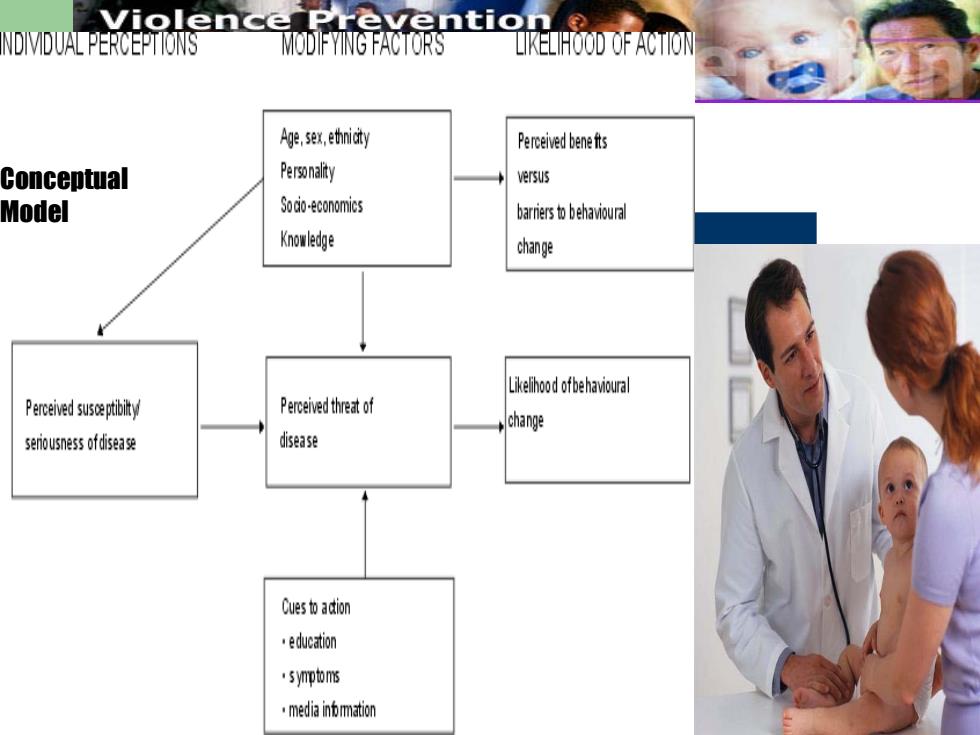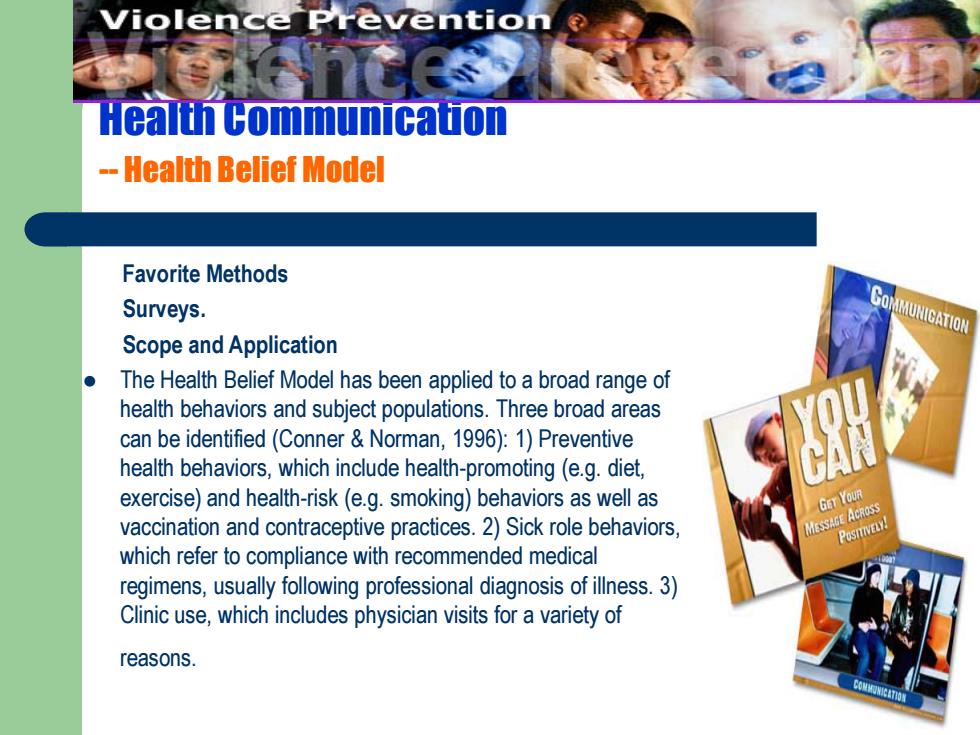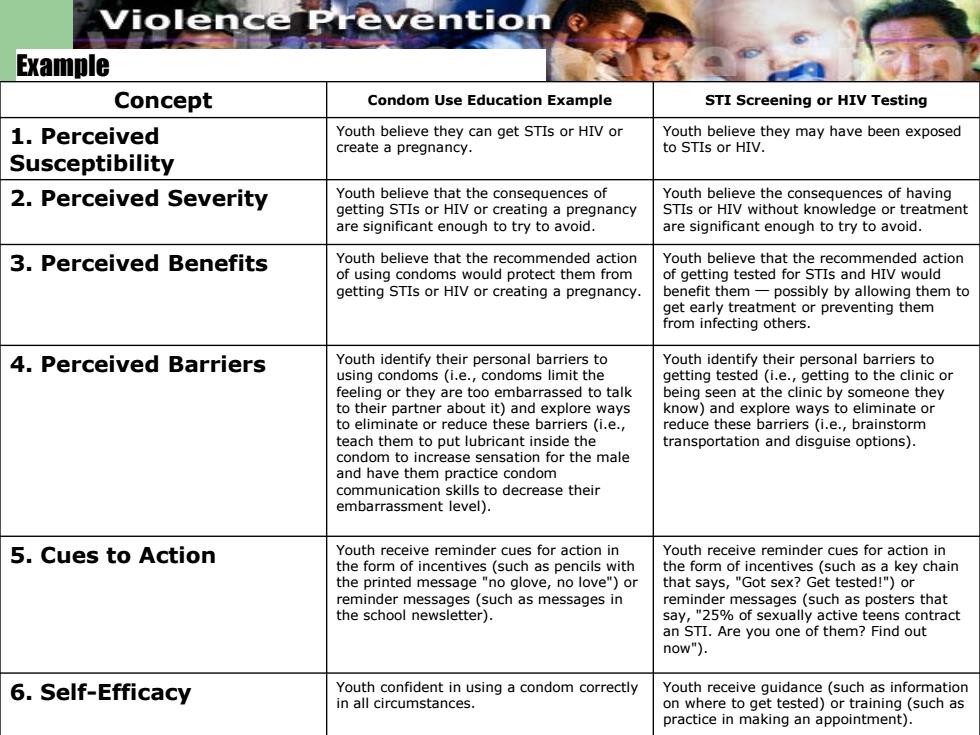
Violence Prevention e Health Communication --Health Belief Model Table from "Theory at a Glance:A Guide for Health Promotion Practice"(1997) Concept Definition Application One's opinion of Perceived Define population(s)at risk,risk levels;personalize risk based chances of getting on a person's features or behavior;heighten perceived n Susceptibility a condition susceptibility if too low. the Perceived One's opinion of how serious a Severity condition and its Specify consequences of the risk and the condition consequences are One's belief in the efficacy of Perceived the advised action to Define action to take;how,where,when;clarify the positive Benefits reduce risk or seriousness effects to be expected. with of impact Perceived One's opinion of the tangible Identify and reduce barriers through reassurance, Barriers and psychological costs of the advised action incentives,assistance. Love Cues to Action Strategies to activate Provide how-to information,promote anding "readiness" awareness,reminders. o Care n with Self-Efficacy Confidence in one's ability to take action Provide training,guidance in performing action. bilities Jack Canfield,Mark Victor Hansen, Karen Simmons,and Heather McNamara
Health Communication -- Health Belief Model Concept Definition Application Perceived Susceptibility One's opinion of chances of getting a condition Define population(s) at risk, risk levels; personalize risk based on a person's features or behavior; heighten perceived susceptibility if too low. Perceived Severity One's opinion of how serious a condition and its consequences are Specify consequences of the risk and the condition Perceived Benefits One's belief in the efficacy of the advised action to reduce risk or seriousness of impact Define action to take; how, where, when; clarify the positive effects to be expected. Perceived Barriers One's opinion of the tangible and psychological costs of the advised action Identify and reduce barriers through reassurance, incentives, assistance. Cues to Action Strategies to activate "readiness" Provide how-to information, promote awareness, reminders. Self-Efficacy Confidence in one's ability to take action Provide training, guidance in performing action. Table from “Theory at a Glance: A Guide for Health Promotion Practice" (1997)

Violence Prevention NDIMDUAL PERCEPTIONS MODIFYING FACTORS LIKELTHOOD OF ACTION Age.sex,ethnicty Perceived benes Conceptual Persnaity versus Model Soc0-economics barrs behavioura Knoledge change Likeiodofbehavioura Perceived susptiby Perceived threof change serousnes50 fdisea实 disease Cuestio .educatio ·symptoms mediaimation
Health Communication Conceptual -- Health Belief Model Model

Violence Prevention e Health Communication --Health Belief Model Favorite Methods Surveys. MMUNICATION Scope and Application ● The Health Belief Model has been applied to a broad range of health behaviors and subject populations.Three broad areas can be identified(Conner Norman,1996):1)Preventive health behaviors,which include health-promoting (e.g.diet, exercise)and health-risk(e.g.smoking)behaviors as well as GEY YouR vaccination and contraceptive practices.2)Sick role behaviors, MESSAGE ACROSS which refer to compliance with recommended medical regimens,usually following professional diagnosis of illness.3) Clinic use,which includes physician visits for a variety of reasons
Health Communication -- Health Belief Model Favorite Methods Surveys. Scope and Application The Health Belief Model has been applied to a broad range of health behaviors and subject populations. Three broad areas can be identified (Conner & Norman, 1996): 1) Preventive health behaviors, which include health-promoting (e.g. diet, exercise) and health-risk (e.g. smoking) behaviors as well as vaccination and contraceptive practices. 2) Sick role behaviors, which refer to compliance with recommended medical regimens, usually following professional diagnosis of illness. 3) Clinic use, which includes physician visits for a variety of reasons

Violence Preventior Example Concept Condom Use Education Example STI Screening or HIV Testing 1.Perceived Youth believe they can get STIs or HIV or Youth believe they may have been exposed create a pregnancy. to STIs or HIV. Susceptibility 2.Perceived Severity Youth believe that the consequences of Youth believe the consequences of having getting STIs or HIV or creating a pregnancy STIs or HIV without knowledge or treatment are significant enough to try to avoid. are significant enough to try to avoid. 3.Perceived Benefits Youth believe that the recommended action Youth believe that the recommended action of using condoms would protect them from of getting tested for STIs and HIV would getting STIs or HIV or creating a pregnancy. benefit them-possibly by allowing them to get early treatment or preventing them from infecting others. 4.Perceived Barriers Youth identify their personal barriers to Youth identify their personal barriers to using condoms (i.e.,condoms limit the getting tested(i.e.,getting to the clinic or feeling or they are too embarrassed to talk being seen at the clinic by someone they to their partner about it)and explore ways know)and explore ways to eliminate or to eliminate or reduce these barriers (i.e., reduce these barriers (i.e.,brainstorm teach them to put lubricant inside the transportation and disguise options). condom to increase sensation for the male and have them practice condom communication skills to decrease their embarrassment level). 5.Cues to Action Youth receive reminder cues for action in Youth receive reminder cues for action in the form of incentives(such as pencils with the form of incentives (such as a key chain the printed message "no glove,no love")or that says,"Got sex?Get tested!")or reminder messages(such as messages in reminder messages (such as posters that the school newsletter). say,"25%of sexually active teens contract an STI.Are you one of them?Find out now"). 6.Self-Efficacy Youth confident in using a condom correctly Youth receive guidance(such as information in all circumstances. on where to get tested)or training (such as practice in making an appointment)
Health Communication -- Health Belief Model Example Concept Condom Use Education Example STI Screening or HIV Testing 1. Perceived Susceptibility Youth believe they can get STIs or HIV or create a pregnancy. Youth believe they may have been exposed to STIs or HIV. 2. Perceived Severity Youth believe that the consequences of getting STIs or HIV or creating a pregnancy are significant enough to try to avoid. Youth believe the consequences of having STIs or HIV without knowledge or treatment are significant enough to try to avoid. 3. Perceived Benefits Youth believe that the recommended action of using condoms would protect them from getting STIs or HIV or creating a pregnancy. Youth believe that the recommended action of getting tested for STIs and HIV would benefit them — possibly by allowing them to get early treatment or preventing them from infecting others. 4. Perceived Barriers Youth identify their personal barriers to using condoms (i.e., condoms limit the feeling or they are too embarrassed to talk to their partner about it) and explore ways to eliminate or reduce these barriers (i.e., teach them to put lubricant inside the condom to increase sensation for the male and have them practice condom communication skills to decrease their embarrassment level). Youth identify their personal barriers to getting tested (i.e., getting to the clinic or being seen at the clinic by someone they know) and explore ways to eliminate or reduce these barriers (i.e., brainstorm transportation and disguise options). 5. Cues to Action Youth receive reminder cues for action in the form of incentives (such as pencils with the printed message "no glove, no love") or reminder messages (such as messages in the school newsletter). Youth receive reminder cues for action in the form of incentives (such as a key chain that says, "Got sex? Get tested!") or reminder messages (such as posters that say, "25% of sexually active teens contract an STI. Are you one of them? Find out now"). 6. Self-Efficacy Youth confident in using a condom correctly in all circumstances. Youth receive guidance (such as information on where to get tested) or training (such as practice in making an appointment)

Violence Prevention Example Health Communication --Health Belief Model References WIDESCREEN/FULL SCREEN Key publications Conner,M.Norman,P.(1996).Predicting Health Behavior.Search and Practice LARRY THE CABLE GUY: with Social Cognition Models.Open University Press:Ballmore:Buckingham. Glanz,K.,Rimer,B.K.Lewis,F.M.(2002).Health Behavior and Health Education. Theory,Research and Practice.San Fransisco:Wiley Sons. Glanz,K.,Marcus Lewis,F.Rimer,B.K.(1997).Theory at a Glance:A Guide for Health Promotion Practice.National Institute of Health. Eisen,M et.al.(1992).A Health Belief Model-Social Learning Theory Approach to Adolescents'Fertility Control:Findings from a Controlled Field Trial.Health Education Quarterly.Vol.19. Rosenstock,1.(1974).Historical Origins of the Health Belief Model.Health Education Monographs.Vol.2 No.4. Becker,M.H.The Health Belief Model and Personal Health Behavior.Health Education Monographs.Vol.2 No.4. Champion,V.L.(1984).Instrument development for health belief model constructs, Advances in Nursing Science,6,73-85. Becker,M.H.,Radius,S.M.,Rosenstock,I.M.(1978).Compliance with a medical regimen for asthma:a test of the health belief model,Public Health Reports,93, 268-77 THEY'LL GIVE ANYONE A BADGE
Health Communication -- Health Belief Model Example References Key publications Conner, M. & Norman, P. (1996). Predicting Health Behavior. Search and Practice with Social Cognition Models. Open University Press: Ballmore: Buckingham. Glanz, K., Rimer, B.K. & Lewis, F.M. (2002). Health Behavior and Health Education. Theory, Research and Practice. San Fransisco: Wiley & Sons. Glanz, K., Marcus Lewis, F. & Rimer, B.K. (1997). Theory at a Glance: A Guide for Health Promotion Practice. National Institute of Health. Eisen, M et.al. (1992). A Health Belief Model — Social Learning Theory Approach to Adolescents' Fertility Control: Findings from a Controlled Field Trial. Health Education Quarterly. Vol. 19. Rosenstock, I. (1974). Historical Origins of the Health Belief Model. Health Education Monographs. Vol. 2 No. 4. Becker, M.H. The Health Belief Model and Personal Health Behavior. Health Education Monographs. Vol. 2 No. 4. Champion, V.L. (1984). Instrument development for health belief model constructs, Advances in Nursing Science, 6, 73-85. Becker, M.H.,Radius, S.M., & Rosenstock, I.M. (1978). Compliance with a medical regimen for asthma: a test of the health belief model, Public Health Reports, 93, 268-77